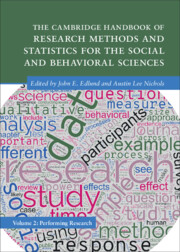 The Cambridge Handbook of Research Methods and Statistics for the Social and Behavioral Sciences
The Cambridge Handbook of Research Methods and Statistics for the Social and Behavioral Sciences Book contents
- The Cambridge Handbook of Research Methods and Statistics for the Social and Behavioral Sciences
- Cambridge Handbooks in Psychology
- The Cambridge Handbook of Research Methods and Statistics for the Social and Behavioral Sciences
- Copyright page
- Dedication
- Contents
- Figures
- Tables
- Contributors
- Preface
- Part I Quantitative Data Collection Sources
- 1 Student Samples in Research
- 2 Mechanical Turk: A Versatile Tool in the Behavioral Scientist’s Toolkit
- 3 Social Media Research
- 4 Prolific: Crowdsourcing Academic Online Research
- 5 Field Research
- 6 Organizational Research
- 7 Integrating Culture in Research
- 8 Mixed Methods and Multimethod Research
- Part II Important Methodological Considerations
- Part III Self-Report Measures
- Part IV Behavioral Measures
- Part V Physiological Measures
- Part VI Qualitative Data Collection Sources
- Index
- References
6 - Organizational Research
from Part I - Quantitative Data Collection Sources
Published online by Cambridge University Press: 12 December 2024
- The Cambridge Handbook of Research Methods and Statistics for the Social and Behavioral Sciences
- Cambridge Handbooks in Psychology
- The Cambridge Handbook of Research Methods and Statistics for the Social and Behavioral Sciences
- Copyright page
- Dedication
- Contents
- Figures
- Tables
- Contributors
- Preface
- Part I Quantitative Data Collection Sources
- 1 Student Samples in Research
- 2 Mechanical Turk: A Versatile Tool in the Behavioral Scientist’s Toolkit
- 3 Social Media Research
- 4 Prolific: Crowdsourcing Academic Online Research
- 5 Field Research
- 6 Organizational Research
- 7 Integrating Culture in Research
- 8 Mixed Methods and Multimethod Research
- Part II Important Methodological Considerations
- Part III Self-Report Measures
- Part IV Behavioral Measures
- Part V Physiological Measures
- Part VI Qualitative Data Collection Sources
- Index
- References
Summary
This chapter focuses on the study of organizations as complex and dynamic social systems. We start our discussion of quantitative organizational research by outlining what organizations are and why we need to study them. We dive into doing research in organizations with specific focus on using theory to guide research methods and three critical organizational dimensions that should inform research design choices: units and levels of analysis, structures and hierarchies, and time and change. We then present and analyze the potential and limitations of descriptive, correlational, and experimental designs in organizational research, using contemporary examples of research to ground our analysis. We also cover data collection considerations, sampling strategies, and sources of organizational data. We close this chapter with discussions of equity issues, in particular ethics, diversity, and inclusion in organizational research.
- Type
- Chapter
- Information
- The Cambridge Handbook of Research Methods and Statistics for the Social and Behavioral SciencesVolume 2: Performing Research, pp. 116 - 139Publisher: Cambridge University PressPrint publication year: 2024
